Research Article - (2023) Volume 10, Issue 2
Received: 07-Feb-2023, Manuscript No. IPADT-23-15667; Editor assigned: 09-Feb-2023, Pre QC No. IPADT-23-15667 (PQ); Reviewed: 23-Feb-2023, QC No. IPADT-23-15667; Revised: 07-Mar-2023, Manuscript No. IPADT-23-15667 (R); Published: 14-Mar-2023, DOI: 10.35841/2349-7211.10.2.11
Currently, the use of plant based natural gums and mucilage are increased in manufacturing of pharmaceutical dosage forms as retarding polymers and excipients, because these natural plant based materials are biocompatible, biodegradable, free of side effects and economic. Therefore in the present research work, eight different formulations of vildagliptin matrix tablets were formulated with Hibisus leaves mucilage, zein powder and tamarind seed polysaccharide as natural polymers to sustain and extend the vildagliptin release from the matrix system and wet granulation technique used for preparation of matrix tablets. The prepared matrix tablets were evaluated for pre-compression and post-compression parameters. Hence the developed matrix tablets of all the formulations passed all the standard evaluation tests (pre-compression and post-compression parameters) and the difference between both the polymers in terms of drug release was examined. V1 formulation extended the release unto 24 hrs, considered as best formulation. The dissolution data of all formulations fitted into kinetic models like zero order equation, first order equation, Hixson Crowell equation, Higuchi equation and Korsemeyer-peppas equation in order to determine the order of drug release and mechanism. The release kinetics of best formulations showed zero order release and followed Higuchi mechanism.
Vildagliptin; Tamarind seed polysaccharide; Zein powder; Matrix tablets; Sustained release
Oral route is well known, important drug delivery system with ease of administration and cost effective. In that sustained release tablets are important drug delivery systems and are designed to release the drug constantly and continuously for prolonged period of time in order to maintain the drug plasma concentration within the therapeutic level as compared to other dosage forms. Diabetes Mellitus (DM) belongs to a group of metabolic diseases, which are characterized by prolonged maintenance of high blood sugar levels, which are divided into two major groups: Type-1 diabetes and type-2 diabetes. Type-1 is caused by pancreatic β-cell dysfunction. Vildagliptin is an amino acid derivative, which stimulates insulin secretion from pancreas, and decreases the plasma (blood) glucose levels. The therapeutic action of vildagliptin is depends upon functioning beta cells in the pancreatic islets [1].
The objective of the study aimed to develop and evaluate vildagliptin sustained release matrix tablet using zein powder and tamarind seed polysaccharide at different concentrations. Zein powder (prolamine family) is rate retarding polymer, composed of high amounts of hydrophobic amino acids (>50%) like proline, glutamine and asparagines. Tamarind seed polysaccharide (Tamarindus indica) is also retarding agent belongs to leguminous tree (Fabacea family) bearing edible fruit [2].
Materials
Vildagliptin is an antidiabetic drug, was gifted from Shodhana laboratories Ltd, Hyderabad, India. Zein and tamarind seed polysaccharide were collected from Cisco research labs pvt ltd, Mumbai. Microcrystalline cellulose (Avicel PH 101) was a gift from Signet chemicals Mumbai, India. Isopropyl alcohol was gift from Anshul agencies, Mumbai, India [3]. Magnesium stearate and talc were procured from S.D. fine chemicals, Mumbai, India. All the chemicals used in the study were of analytical grade.
Extraction of Mucilage from Hibiscus rosa-sinensis Leaves
Fresh leaves of Hibiscus rosa-sinensis (Class: Magnoliopsida; Family: Malvaceae) were used for mucilage extraction. Dirt and debris associated with collected leaves were removed by cleaning repeatedly with adequate water [4]. The cleaned leaves were subjected to drying until they become crispy. The dried leaves were crushed and maintained under soaking for 5-6 hours. All soaked leaves were boiled for 30 min and later on kept undisturbed for 1 hour to allow the complete release of mucilage into water. An eight-fold muslin cloth bag was used to extract the mucilage by removing marc from solution. Then resultant filtrate solution was mixed with acetone (three times to filtrate’s volume) to precipitate the mucilage. The precipitated mucilage was separated carefully and dried in an oven at 40°C. The dried product was ground to get HRLM powder, passed through sieve number # 80 and stored in desiccator at 35°C and 45% relative humidity till use [5].
Extraction of Tamarind Seed Polysaccharide (TSP)
Seeds from tamarind fruits (Plant: Tamarindus indica L.; sub-family: Caesalpinioideae; Family: Fabaceae/Leguminosae) were collected from local area and washed with distilled water to remove adherent material. Air dried seeds were roasted at 140°C for 10 min to enable the formation of a gap between testa and kernel in each seed [6]. Then roasted seeds were hammered to break the brittle testa and kernel was separated from each seed. All the separated kernels were cleaned with water, air dried and powdered to get Tamarind Kernel Powder (TKP).
A slurry was prepared by mixing 20 g of TKP with 200 ml distilled water. The resultant slurry was added to 800 ml water and boiled for 20 min with continuous stirring. Then obtained thin clear solution was cooled and kept undisturbed overnight to enable the maximum settling out of proteins and fibers. A clear supernatant liquid (formed after the centrifugation at 5000 rpm for 20 min) was separated from solution and mixed with doubled volume proportion of absolute ethanol to facilitate TSP precipitation [7]. The precipitate was then collected, washed with absolute ethanol and dried in an oven for 10°C hours at 50°C. Completely dried TSP was powdered, passed through sieve number 60 and stored in a desiccator until further use.
Preparation of SR Matrix Tablets of Miglitol
Formulation compositions were developed using suitable experimental design to study the effect of selected three factors on predetermined response. Pre-formulation studies like drug-excipient compatibility study and flow property evaluation were conducted to know the suitability of developed blend compositions for tablet compression (Table 1).
Experimental design: Total eight tablet formulations were developed for each drug by applying 23 factorial design using ‘Design expert software’. The objective of this design was to study the effect of three independent factors like amount of HRLM (A), amount of ZP (B) and amount of TSP (C) on drug release characteristics. Each factor was studied at two levels designated as -1 (60 mg; 15% w/w) and +1 (80 mg; 20% w/w). The randomized combinations were generated based on Design of Experiments (DOE). The designed combinations of factors were used as a base to develop eight different formulation compositions for each drug [8]. The response (dependent) variable studied for each formulation was ‘cumulative % drug release after 24 hours.
| Formulation code | Level of factor in formulations | ||
|---|---|---|---|
| A (Amount of HRLM) | B (Amount of ZP) | C (Amount of TSP) | |
| F1 | -1 | -1 | -1 |
| F2 | 1 | -1 | -1 |
| F3 | -1 | 1 | -1 |
| F4 | 1 | 1 | -1 |
| F5 | -1 | -1 | 1 |
| F6 | 1 | -1 | 1 |
| F7 | -1 | 1 | 1 |
| F8 | 1 | 1 | |
| -1 → 60 mg; +1 → 80 mg | |||
Table 1: Randomized possible compositions as per DOE.
Pre Formulation Studies
Physicochemical properties of the drug and its blend with other excipients can be investigated by conducting pre formulation studies. The formulation blends prepared as per above developed compositions were used for:
• Compatibility study.
• Evaluation of flow properties.
Standard graph of drug was also constructed in pre formulation studies.
Compatibility Study
Blended samples were analyzed using Fourier Transform Infrared (FTIR) spectrophotometer to interpret the interactions of drug with polymers and other ingredients. The powder blend along with potassium bromide was used for FTIR studies. The IR spectrum of a) Pure drug; b) Physical mixture containing drug, polymers and other ingredients, were taken, interpreted and compared with each other [9].
Characterization of Formulation Powder Mixture for Flow Property
The physicochemical properties of a formulation blend are deciding factors of tablet compression and output quality. Mainly, flow property of blend (powder/granular) is an important characteristic that plays a major role in compression process. The following properties of formulation blend were determined to interpret its flow property [10].
Angle of Repose
It is defined as maximum possible angle between surface of blend’s pile and its horizontal plane. If more powder bed is added to previously formed pile, it slides down the sides until mutual friction of particles producing a surface angle θ is in equilibrium with gravitational force. The angle of repose (θ) values of formulation blends were measured using fixed funnel [11]. A funnel was tightly fixed to a stand by keeping funnel’s lower tip at predetermined known height (h) above a graph paper placed on a flat horizontal surface. Pouring of formulation blend through the funnel was started. It was continued until formed apex of conical pile just touches the lower tip of funnel stem. Then, radius (r) of the base of conical pile was measured (Table 2). The angle of repose (θ) was calculated using below mentioned formula:
θ=Tan-1[h/r]
| Flow property | Angle of repose (degrees) |
|---|---|
| Excellent | 25–30 |
| Good | 31–35 |
| Fair—aid not needed | 36–40 |
| Passable—may hang up | 41–45 |
| Poor—must agitate, vibrate | 46–55 |
| Very poor | 56–65 |
| Very, very poor | >66 |
Table 2: Pharmacopoeial specifications for angle of repose.
Compressibility Index and Hausner Ratio
The compressibility index (Carr’s Index) is a measure for flow nature of a formulation blend to be compressed. It is calculated using both bulk and tapped density values of powder blend.
Bulk density: Bulk density (ρb) value can be calculated by dividing the mass of powder blend with its bulk volume and is expressed as g/ml. Its value primarily depends on powder particulate properties like size distribution, shape and the tendency of particles to adhere together [12]. The dried 10 ml cylinder was taken and a fixed Mass (M) of blend was introduced into it. Inside content was carefully leveled without compacting and noted the value of unsettled apparent Volume (V0). The bulk density was calculated using following formula:
ρb = M/V0
Tapped density: This value (ρtap) is represented by the ratio of blend’s total mass (M) to its final tapped Volume (Vf). First, the tapping of powder blend was done for 500 times and its volume was measured. Then tapings were increased up to 750 times and the volume was noted for second time. Tapping was continued until the difference between two consecutive volumes was <2%. Then Vf was measured to the nearest graduated unit. The tapped density was calculated in g/ml using below mentioned formula:
ρtap = M/Vf
Carr’s Index (CI) and Hausner ratio are the measures of inter particulate interactions in a powder blend (Table 3). The values of bulk and tapped densities will be closer in a free flowing powder due to les significant interactions. CI and Hausner ratio were calculated using the following formula:
Carr’s index=((ρtap–ρb)/ρtap) X 100; and Hausner ratio=ρtap/ρb
| Compressibility index (%) | Flow character | Hausner ratio |
|---|---|---|
| ≤ 10 | Excellent | 1.00–1.11 |
| 11-15 | Good | 1.12–1.18 |
| 16-20 | Fair | 1.19–1.25 |
| 21-25 | Passable | 1.26–1.34 |
| 26-31 | Poor | 1.35–1.45 |
| 32-37 | Very poor | 1.46–1.59 |
| >38 | Very, very poor | >1.60 |
Table 3: Pharmacopoeial specifications for Carr’s index and Hausner ratio.
Construct on of Standard Graph of Drug(s)
Calibration curves of three drugs were plotted separately. Curve of each drug was drawn in 0.1 N HCl and pH 6.8 phosphate buffers, separately (Table 4). Each drug was scanned spectrophotometrically at its respective λ max value as follows:
| Drug | λmax |
|---|---|
| Miglitol | 220 nm |
| Nateglinide | 210 nm |
| Vildagliptin | 210 nm |
Table 4: Absorption maxima of drug.
Preparation of 0.1 N HCl: 8.5 ml of concentrated HCl was taken in 1000 ml volumetric flask and diluted with distilled water up to mark.
Preparation of pH 6.8 phosphate buffer: It was prepared by mixing 250 ml of 0.2 M potassium dihydrogen phosphate solution with 112 ml of 0.2 M sodium hydroxide in a 1000 ml volumetric flask. The resultant mixture was diluted with distilled water up to mark.
Preparation of standard solution samples:
• First stock solution was prepared by dissolving 100 mg
drug in 100 ml of concerned medium (0.1 N HCl or pH 6.8
phosphate buffer), so as to get 1000 μg/ml concentration.
• Then a sample of 10 ml from above stock was diluted to
100 ml using same medium, so as to geta second solution
with 100 μg/ml concentration.
• Accurately measured aliquot portions of second solution,
like 0.2 ml, 0.4 ml, 0.6 ml, 0.8 ml, 1.0 ml and 1.2 ml were
transferred in to 10 ml volumetric flasks. Then all the
samples were diluted up to mark with medium. The final
concentrations of diluted solutions were ranged from 2
μg/ml-12 μg/ml.
• Absorbance of each diluted standard drug solution sample
was scanned in UV-Visible spectrophotometer at its
respective λ max using same medium as the blank. A
linear graph was plotted by taking drug concentration on
X-axis and absorbance on Y-axis and the values of slope
(m) and Y-intercept were noted.
Formulat on of SR Matrix Tablets
Matrix tablets of each drug were prepared by direct compression method. Drug and selected polymer powders were passed through sieve number 80 meshes to get uniform fineness. Other excipients were screened through 60 mesh sieve. Formulation bulk was developed using Micro Crystalline Cellulose (MCC) as filler. Magnesium stearate and talc were used to lubricate the formulation blends developed as per experimental design. Lubricated blends were compressed using 9 mm flat faced punches on eight station rotary compression machine (Cadmach Machinery Pvt. Ltd., Ahmedabad).
Evaluation of Compressed Tablets (Post-Formulation Studies)
Compressed tablets were characterized for their physicochemical properties by conducting post-compression studies. First, all the formulations were evaluated by in vitro methods. The results of in vitro studies were analyzed, interpreted and selected best optimized formulation(s) for each drug [13]. The stability of selected tablet batches was studied and then best formulations were evaluated by in vivo methods. Tablets in each formulation were evaluated for weight variation, thickness, hardness, friability, content uniformity, swelling index and drug release characteristics during in vitro studies.
Weight Variation Test
Twenty tablets from each formulation batch were selected randomly and noted their individual weights (n=6). The average weight of one tablet was estimated and calculated percentage deviation of individual reading from average value using following formula:

The % deviation allowed for 400 mg (average weight) tablets as per pharmacopoeia is 5%. The number of tablets possessing more than ± 5% deviation were identified and noted, if any. Mean weight of tablets in each batch was calculated and represented with Standard Deviation (SD) values (Table 5).
| Average weight of tablets (mg) (I.P) | Average weight of tablets (mg) (U.S.P) | Maximum percentage deviation allowed |
|---|---|---|
| Less than 80 | Less than 130 | 10 |
| 80–250 | 130-324 | 7.5 |
| More than 250 | More than 324 | 5 |
Table 5: Pharmacopoeial specifications for tablet weight variation.
Thickness
Tablet thickness is an important characteristic that ensures reproducing appearance twenty tablets were taken randomly from each formulation and noted their thickness values using digital Vernier calipers (n=6). Thickness of the tablets should be controlled in ± 5%. So verified and noted the deviated tablets in each batch. Mean value of each formulation were calculated and represented with SD values.
Hardness
The force applied along tablet diameter is considered as its hardness which is crucial to show resistance towards chipping, abrasion or breakage under conditions of storage, transportation and handling before usage. The hardness of 20 tablets from each batch was noted using Monsanto hardness tester (n=6) and mean values with SD were presented.
Friability
Mechanical strength of prepared dosage units can be estimated by measuring percentage friability using Roche friabilator which consists of one plastic chamber that is set to revolve 25 rpm dropping the tablets from 6 inches’ height with each revolution. The collective weight (Wo) of 20 tablets from each formulation was noted (n=6) and pre-weighed dosage forms were placed in friabilator to revolve for 4 minutes [14]. Then all the tablets were re-weighed collectively and noted as W. The difference in two weights is a measure of friability and it can be expressed in percentage as:

Where;
Wo=Weight of the tablets before test.
W=Weight of the tablets after test.
Mean friability percentage was calculated for each batch and represented with corresponding SD value. The % friability should lie in range of 0.5%-1% as per pharmacopoeia.
Content Uniformity
Randomly selected 20 tablets from each formulation were weighed and one tablet average weight was calculated. Then all 20 tablets were powdered and the powder equivalent to one average tablet weight was taken. The weighed tablet powder was allowed to dissolve in 250 ml of pH 6.8 phosphate buffer on a rotary shaker overnight. The resultant solution was centrifuged to get supernatant. The absorbance of supernatant (after required dilution) was measured using a UV-visible spectrophotometer at required λmax of drug.
Swelling Study
The swelling behavior of all prepared tablets was determined by estimating their Swelling Index (SI) value. SI indicates the extent of swelling in terms of percent weight gain by tablet. Three tablets form each formulation (n=3) were selected and noted their initial weights (W0). Pre-weighed tablets were placed in 8 separate petri dishes (formulation-wise) each containing 20 ml of pH 6.8 phosphate buffer. All the tablets were removed from petri dish after 1 hour (t=1) and placed on a tissue paper for 5 minutes. Then weights of tablets (Wt) were noted and again paced in same petri dishes. In the same way, Wt values were noted after another one hour (t=2) and then later on done for every 2 hours up to 12 hours. The SI value for all tablets was calculated using following formula:
SI=((Wt-W0)/W0) × 100
Where;
Wt=Weight of a tablet at ‘t’ time.
W0=Initial weight of a tablet at ‘0’ time.
Drug Release Study
Multiple dissolution apparatus (Electro lab India pvt. ltd.) was used for in vitro drug release study. Dissolution was carried out using USP type-I (basket) method in 900 ml of medium for 24 hours. The medium used was 0.1 N HCl during first 2 hours and then replaced with pH 6.8 phosphate buffers for continuing remaining study. Samples (5 ml) were withdrawn at predetermined time points and replaced with equal volume of same fresh medium at each collection. The collected samples were scanned in UV-visible spectrophotometer at drug specific λmax. The cumulative % drug release after each collected time point was calculated using standard graph of drug [15].
Drug Release Kinetic Studies
Drug release data obtained through dissolution study was fitted into various kinetic models to assess the kinetics and mechanism of drug release. The relevant linear plots were drawn using MS-Excel-2010 and generated regression equations for each plot. The extent of linearity was assessed with regression coefficient (r2) value. The model which results a plot with highest linearity was selected as best fit model for fitted drug release data. The kinetic models and their equations used in data fitting were as follows:
• Zero order model (Qt=Qo–Kot): Cumulative % drug
released versus time plot was drawn.
• First order model (ln Q=ln Qo–K1t): Log cumulative %
drug remaining to be released versus time plot was drawn.
• Higuchi model (Q=Kht1/2): Cumulative % drug released
versus square root of time plot was drawn.
• Korsmeyer-Peppas model (Mt/Mα=Ktn): Log cumulative %
drug released versus log time plot was drawn.
• Hixson-Crowell cubic root law model (Qo1/3–Qt1/3=Kt):
Cubic root of cumulative % drug remaining to be released
versus time plot was drawn.
In above kinetic equations,
• Qi and Ki=Stand for amount of drug release and release
constant, respectively.
• Mt/Mα=Represents fractional drug release.
• ‘t’=Stands for time point of concerned.
• ‘n’=Diffusional release exponent.
Two-Level Factorial Optimization and Mathematical Modeling
A randomized two level full factorial design was used to analyze the obtained data. After obtaining post-experimental results (in vitro drug release data), a multiple regression analysis was applied to evaluate the regression coefficients of generated mathematical model. The following statistical model incorporating linear terms and interactive terms of three factors studied was used to test the responses: Y= β0+β1A+ β2B+ β3C+ β4AB+ β5AC+ β6BC+ β7ABC
Where;
Y=Response variable.
β0=Arithmetic mean response of all eight runs.
β1, β2 and β3=Estimated coefficients for individual factors A, B
and C respectively.
β4, β5, β6 and β7=Estimated coefficients for interaction terms
AB, AC, BC and ABC respectively.
A, B and C=Indicate main effects that represent the average
result of changing one factor at a time from its low to high
value.
AB, AC and BC are the interaction terms that indicate possible
changes in response when two factors are altered together.
ABC is an interactive term which represents the manner how
response changes when all three factors together subjected
to alteration.
The significance of each term in above said statistical model was evaluated by applying ANOVA test. Only, the significant terms were included in final model. The effect of investigated factors on dependent variable was visualized by drawing ‘3D surface and contour plots’. The optimized formulation and its predicted response were suggested by used statistical model. Then suggested optimized formulation was confirmed as the best by comparing its practically observed drug release with predicted response.
In vitro Drug Release: Marketed Versus Optimized Formulation
Dissolution study was conducted for a marketed product of concerned drug using same parameters and procedure as that used for developed formulations. The drug release profile of selected best optimized formulation was compared with that of marketed tablet.
Stability Studies
Best formulations were selected based on the results of in vitro studies. Accelerated stability studies were conducted for selected best optimized formulation(s) using stability chamber (Bio-Techniques equipment Ltd.). Tablets of each best formulation were divided into 3 batches; strip packed and stored at three different conditions as per ICH guidelines. The three storage conditions used in these studies were as follows:
• Room temperature.
• 30°C temperature and 60% Relative Humidity (RH).
• 40°C temperature and 75% Relative Humidity (RH).
Dosage form samples from each batch were collected at predetermined time intervals of 0, 30, 60, 90 and 180 days. Collected sample units were evaluated for physicochemical parameters like appearance, weight variation, thickness, hardness, friability, drug content and drug release.
In vivo Studies
In vivo studies were conducted to estimate the pharmacokinetic parameters of drug to support in vitro drug release results. These animal studies were performed in male New Zealand white rabbits weighing 2.0 kg to 2.5 kg, after getting approval from Institutional Animal Ethical Committee (IAEC) (approval no. IAEC/05/NCOP/2019). All the rabbits were procured from a registered vendor. Rabbits were divided into 3 groups each consisting of 3 animals and fasted overnight, allowed to take drinking water alone before experimentation. First group (reference) was administered with drug solution (prepared by dissolving dose equivalent quantity in sufficient distilled water). Second and third groups received marketed product and selected best formulation, respectively. All the dose administrations to rabbits were done via gastric intubation. Blood sampling was done from ear vein by holding the animals in rabbit restrainers. Blood samples were collected into heparinized tubes at predetermined intervals of 0.5, 1, 1.5, 2, 4, 8, 12 and 24 hours post administration. Collected blood samples were subjected to cooling centrifugation (Heraeus Biofuge Fresco centrifuge, Germany) at 3500 × g of Relative Centrifugal Force (RCF) and 4°C for 5 minutes to obtain the plasma. Separated test plasma samples were stored at -70°C until further analysis [16].
Analysis of Plasma Drug Concentration using HPLC
A sensitive Reverse Phase High Performance Liquid Chromatography (RP-HPLC) method (Shimadzu corporation, Japan) was used for the estimation of drug in plasma. The samples were analyzed using RP C18 column (250 mm x 4.6 mm, 5 μm, Phenomenex Luna) as stationary phase. The sample run time for analysis was 10 min. Lab solutions software was used to perform all analysis operations and interpret the analyzed data. The following HPLC parameters were used in analysis of samples (Table 6).
| HPLC parameter | Vildagliptin |
|---|---|
| Mobile phase | pH 4.6 phosphate buffer and acetonitrile in the ratio of 60:40 v/v |
| Flow rate | 1 ml/min |
| λmax | 210 nm |
| Internal standard | Metformin |
| First, calibration curve of drug in rabbit plasma was plotted using above said HPLC parameters. | |
Table 6: HPLC Parameters for the analysis of drugs.
Construction of Calibration Curve for Drug
Preparation of stock and working standard solutions: First, a stock solution (100000 ng/ml) was prepared by dissolving accurately weighed amount (10 mg) of drug in 100 ml of HPLC grade methanol. Then 1 ml of above solution was diluted 100 times to get second stock (1000 ng/ml) using same grade methanol. Further dilutions were made to the second stock solution to get working standard solutions in a concentration range of 200 ng/ml-1000 ng/ml. Five standard drug solutions with concentration of 200 ng/ml, 400 ng/ml, 600 ng/ml, 800 ng/ml and 1000 ng/ml were used for standard curve. Preparation of Internal Standard solution (IS): Accurately weighed internal standard drug (10 mg) was dissolved in 10ml of HPLC grade methanol to get a stock solution (1000 μg/ml). Then a working internal standard solution (10 μg/ml) (to be used in further analysis) was prepared by making dilutions to previously obtained stock solution. Preparation of HPLC samples for Standard graph: Blood samples (drug free) were collected from healthy male rabbits and centrifuged to get plasma. Standard drug solutions (each 100 μl) were placed in separate polypropylene centrifuge tubes and 100 μl of plasma sample was added to each. Then internal standard solution (100 μl) was added to each tube and shaken for 1 min. Each resultant mixture was allowed to precipitate by adding methanol (100 μl) and overtaxing for 1 min. Then all the tubes were subjected to centrifugation for 20 min at 3000 rpm to get clear supernatants. Then separated clear supernatants were used as HPLC samples for construction of standard graph. Each sample aliquot (20 μl) with known drug concentration was injected into HPLC column and analyzed at specified wavelength. The peak area of both drug as well as internal standard was noted and peak area ratio was calculated for each sample. Then concentration versus peak area ratio plot (calibration curve) was drawn using MS-Excel. Peak area ratio was calculated as follows:
Peak area ratio=peak area of drug/peak area of internal standard.
Analysis of Test Plasma Samples
Test plasma sample and internal standard (each 100 μl) were mixed in a centrifuge tube. This mixture was shaken for 1 min.
To this mixture, 100 μl of methanol was added for precipitation. The resultant was vortexed and centrifuged for 20 min at 3000 rpm. Then the supernatant was collected and filtered. Now, the collected filtrate was considered as HPLC test plasma sample. Then 20 μl of test sample was injected in to HPLC system for analysis. All test plasma samples were analyzed using same HPLC parameters and obtained ‘peak area ratio’ values. The respective drug concentrations for resulted ‘peak area ratio’ values were calculated using calibration curve of drug. The obtained data of plasma drug concentrations against different time points was applied in Kinetical TM software to calculate important pharmacokinetic parameters like peak plasma concentration (Cmax), Time required to attain Cmax (tmax), Area Under Curve (AUC) and Mean Residence Time (MRT) (Table 7).
| Ingredients (mg) | Formulation code | |||||||
|---|---|---|---|---|---|---|---|---|
| V1 | V2 | V3 | V4 | V5 | V6 | V7 | V8 | |
| Vildagliptin | 50 | 50 | 50 | 50 | 50 | 50 | 50 | 50 |
| HRLM | 60 | 80 | 60 | 80 | 60 | 80 | 60 | 80 |
| ZP | 60 | 60 | 80 | 80 | 60 | 60 | 80 | 80 |
| TSP | 60 | 60 | 60 | 60 | 80 | 80 | 80 | 80 |
| MCC | 162 | 142 | 142 | 122 | 142 | 122 | 122 | 102 |
| Magnesium stearate | 4 | 4 | 4 | 4 | 4 | 4 | 4 | 4 |
| Talc | 4 | 4 | 4 | 4 | 4 | 4 | 4 | 4 |
| Total weight | 400 | 400 | 400 | 400 | 400 | 400 | 400 | 400 |
Table 7: Formulation compositions for vildagliptin SR matrix tablets.
Vildagliptin SR Matrix Tablets
Preformulation Studies: Compatibility Study:
The FTIR analysis of pure vildagliptin powder has resulted a spectrum with following peaks related to specific stretching’s (Figure 1).
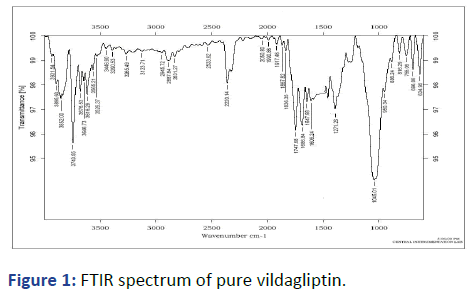
Figure 1: FTIR spectrum of pure vildagliptin.
The FTIR spectrum of powder mixture containing drug and excipients has retained all the above identified peaks related to pure vildagliptin. So, the existence of compatibility among drug and other excipients in a formulation blend was confirmed (Figure 2 and Table 8).
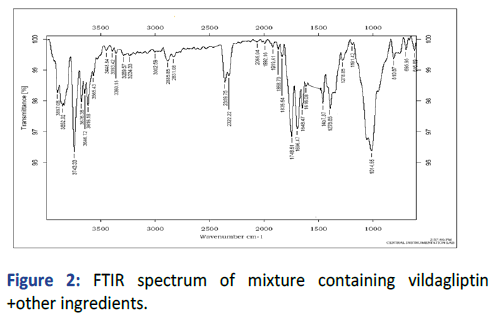
Figure 2: FTIR spectrum of mixture containing vildagliptin +other ingredients.
| Wave number of peak formation (cm-1) | Related stretching |
|---|---|
| 2220.14 | -C≡N |
| 1647.98 | >C=O |
| 1606.24 | >N-H |
| 1271.23 | =C-N |
| 1045.01 | >C-N (ring) |
| 3743.55 | -O-H |
Table 8: Peak regions in FTIR spectrum of Vildagliptin.
Characterization of Formulation Powder Mixture for its Flow Property
All the values of angle of repose, Carr’s index and Hausner ratio were bound to Pharmacopoeial limits and these results have given an idea about flow nature of all developed formulation blends. All the formulation powder mixtures have possessed a flow characteristic of Excellent too good. So, all blends were proved to be suitable for direct compression (Table 9).
| Formulation blend | Angle of repose (in°) | Carr’s index (%) | Hausner ratio |
|---|---|---|---|
| V1 | 23.82 | 12.73 | 1.22 |
| V2 | 24.29 | 11.28 | 1.31 |
| V3 | 23.88 | 10.76 | 1.07 |
| V4 | 20.79 | 11.49 | 1.13 |
| V5 | 23.26 | 12.29 | 1.11 |
| V6 | 24.66 | 12.17 | 1.12 |
| V7 | 21.61 | 10.09 | 1.13 |
| V8 | 23.19 | 11.37 | 1.04 |
Table 9: Flow property characterization of vildagliptin formulation blends.
Standard Graph of Vildagliptin
Two standard graphs of vildagliptin plotted in different media have shown a good linearity with R2 value of 0.9996 (0.1N HCl) and 0.9997 (pH 6.8 phosphate buffer) (Table 10). The obtained absorbances were proportional to concentrations. Both graphs were in accordance with ‘Beer-Lambert’ law (Figures 3 and 4).
| Concentration (µg/ml) | Absorbance (0.1 N HCl) | Absorbance (pH 6.8 phosphate buffer) |
|---|---|---|
| 0 | 0 | 0 |
| 2 | 0.113 | 0.161 |
| 4 | 0.206 | 0.296 |
| 6 | 0.311 | 0.441 |
| 8 | 0.421 | 0.582 |
| 10 | 0.518 | 0.729 |
| 12 | 0.619 | 0.869 |
Table 10: Standard graph of Vildagliptin using UV method.
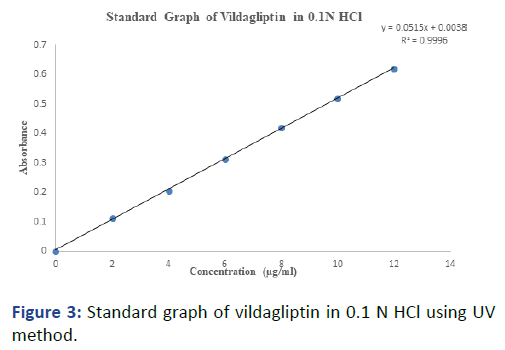
Figure 3: Standard graph of vildagliptin in 0.1 N HCl using UV method.
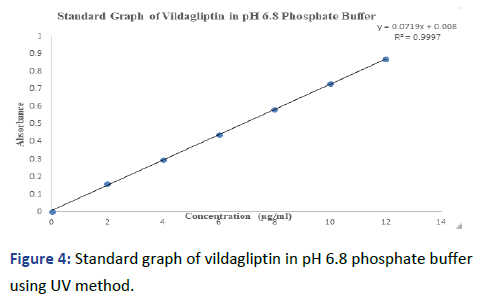
Figure 4: Standard graph of vildagliptin in pH 6.8 phosphate buffer using UV method.
Evaluation of Compressed Tablets (Post-Formulation Studies
In vitro studies
Weight variation, hardness, thickness: The weights of individual tablets in each formulation were uniform and not deviated from 398.78 ± 1.64 mg (V6) to 403.71 ± 0.99 mg (V5). The hardness values of all prepared tablets were ranged from 4.1 ± 0.13 kg/cm2 (V3) to 4.3 ± 0.16 kg/cm2 (V5). The thickness of all tablets was uniform and no deviation has been noticed as per standard pharmacopoeial values as per pharmacopoeial limits. The average weights of eight formulations were ranged (Table 11).
| Formulation | Weight (mg) | Hardness (kg/cm2) | Thickness (mm) |
|---|---|---|---|
| V1 | 402.46 ± 1.27 | 4.2 ± 0.33 | 3.47 ± 0.21 |
| V2 | 401.74 ± 0.91 | 4.2 ± 0.19 | 3.49 ± 0.31 |
| V3 | 403.27 ± 1.49 | 4.1 ± 0.13 | 3.46 ± 0.29 |
| V4 | 400.66 ± 1.34 | 4.2 ± 0.27 | 3.48 ± 0.09 |
| V5 | 403.71 ± 0.99 | 4.3 ± 0.16 | 3.47 ± 0.11 |
| V6 | 398.78 ± 1.64 | 4.2 ± 0.22 | 3.49 ± 0.17 |
| V7 | 399.56 ± 1.42 | 4.2 ± 0.48 | 3.51 ± 0.07 |
| V8 | 402.09 ± 0.81 | 4.1 ± 0.15 | 3.48 ± 0.45 |
| *All the values are represented as Mean ± SD | |||
Table 11: Mean weight, hardness and thickness of Vildagliptin formulation.
Friability and content uniformity: All resulted values of percentage friability were within the pharmacopoeial standard range (0.5%-1%). The friability values of formulations were ranged from 0.52 ± 0.13% (V7) to 0.72 ± 0.11% (V4). The % drug content (assay) values in all formulations were uniform and maximum to prescribed dose. These values were ranged from 98.34 ± 0.55% (V8) to 102.46± 2.01% (V4). The obtained results were found to be acceptable as per pharmacopoeial standards (Table 12).
| Formulation | Friability (%) | Drug content (%) |
|---|---|---|
| V1 | 0.69 ± 0.14 | 101.06 ± 1.03 |
| V2 | 0.71 ± 0.05 | 99.41 ± 0.84 |
| V3 | 0.67 ± 0.18 | 98.79 ± 1.21 |
| V4 | 0.72 ± 0.11 | 102.46 ± 2.01 |
| V5 | 0.58 ± 0.26 | 99.38 ± 0.67 |
| V6 | 0.66 ± 0.14 | 99.18 ± 0.79 |
| V7 | 0.52 ± 0.13 | 101.45 ± 1.49 |
| V8 | 0.67 ± 0.12 | 98.34 ± 0.55 |
| *All the values are represented as Mean SD | ||
Table 12: Percentage friability and drug content of vildagliptin formulations.
Swelling index: From the results Table 1 and Figure 1 of swelling study, it was understood that all used polymers in vildagliptin formulations have a property of hydrophilicity which is responsible for tablet swelling. The enhancement in swelling percentagehasbeen increased with time up to 12 hours. The hike in SI values of formulations has been noticed with enhanced polymer proportion within a tablet dosage form. Comparatively, TSP polymer was found to be more hydrophilic with enhanced swelling nature and high matrix forming ability [17].
Formulation N1 having a composition of three polymers each at lower amount (60 mg) has shown less SI values, whereas more swelling had been seen with N8 tablets due to higher quantity (80 mg) of each polymer (Table 13 and Figure 5).
| Time (hrs) | Swelling index (%) | |||||||
|---|---|---|---|---|---|---|---|---|
| V1 | V2 | V3 | V4 | V5 | V6 | V7 | V8 | |
| 0 | 0 | 0 | 0 | 0 | 0 | 0 | 0 | 0 |
| 1 | 16.26 ± 1.22 | 14.59 ± 1.82 | 17.94 ± 1.19 | 15.62 ± 1.46 | 18.34 ± 1.97 | 20.37 ± 1.07 | 16.94 ± 1.33 | 30.51 ± 1.89 |
| 2 | 42.94 ± 1.37 | 36.61 ± 1.54 | 36.84 ± 1.37 | 37.42 ± 2.52 | 42.64 ± 1.75 | 36.94 ± 1.55 | 39.64 ± 1.84 | 51.77 ± 2.87 |
| 4 | 47.85 ± 1.46 | 61.27 ± 1.07 | 54.87 ± 2.66 | 66.09 ± 2.77 | 63.84 ± 2.66 | 81.44 ± 2.67 | 69.71 ± 2.67 | 92.64 ± 3.64 |
| 6 | 88.34 ± 2.03 | 92.48 ± 2.64 | 88.21 ± 2.49 | 97.18 ± 1.85 | 102.45 ± 3.27 | 124.61 ± 2.97 | 102.64 ± 3.82 | 133.52 ± 4.28 |
| 8 | 107.84 ± 2.74 | 114.027 ± 2.97 | 116.94 ± 3.16 | 125.67 ± 3.49 | 127.64 ± 3.86 | 143.67 ± 3.22 | 131.27 ± 4.67 | 161.94 ± 4.97 |
| 10 | 144.87 ± 2.67 | 152.94 ± 3.45 | 166.26 ± 3.78 | 162.42 ± 4.09 | 156.94 ± 4.84 | 187.61 ± 4.67 | 171.55 ± 4.98 | 194.76 ± 5.23 |
| 12 | 182.36 ± 3.29 | 203.48 ± 3.66 | 195.62 ± 3.87 | 234.15 ± 4.86 | 221.64 ± 4.67 | 262.34 ± 4.99 | 243.27 ± 4.67 | 273.45 ± 5.87 |
Table 13: Swelling index of vildagliptin SR matrix tablets.
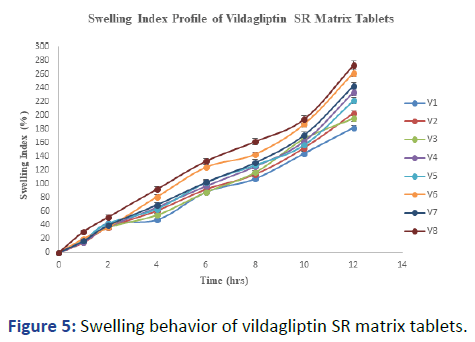
Figure 5: Swelling behavior of vildagliptin SR matrix tablets.
Drug release study: The observed release pattern from tablets in dissolution study was in sustained manner. No considerable vildagliptin release was seen during first two hours in 0.1N HCL medium. Then a gradual hike in drug release was noticed in pH 6.8 phosphate buffer during 2-24 hours. The results revealed that the extent of drug release was affected by both type and amount of rate retarding polymer. The quantity of each polymer in every formulation has shown its effect on drug release. A reduced drug release had been noticed with increased polymer quantity and the more impact was shown by TSP followed by HRLM and ZP. Maximum drug release (93.63 ± 2.66%) has been noticed from V1 formulation because of having a composition of three polymers each at lower level (60 mg). The drug release from V8 formulation was minimum (74.35 ± 1.87%) due to more swelling and matrix formation by three retardant polymers each at higher level (80 mg) (Table 14 and Figure 6).
| Time (hrs) | Cumulative % of vildagliptin release | |||||||
|---|---|---|---|---|---|---|---|---|
| V1 | V2 | V3 | V4 | V5 | V6 | V7 | V8 | |
| 0 | 0 | 0 | 0 | 0 | 0 | 0 | 0 | 0 |
| 0.5 | 0.21 ± 0.05 | 0.38 ± 0.08 | 0.21 ± 0.07 | 0.21 ± 0.03 | 0.38 ± 0.06 | 0.03 ± 0.07 | 0.21 ± 0.08 | 0.38 ± 0.06 |
| 1 | 0.73 ± 0.14 | 0.56 ± 0.19 | 0.56 ± 0.17 | 0.38 ± 0.13 | 0.56 ± 0.14 | 0.56 ± 0.16 | 0.38 ± 0.14 | 0.56 ± 0.12 |
| 1.5 | 1.08 ± 0.19 | 0.91 ± 0.21 | 1.26 ± 0.24 | 0.91 ± 0.18 | 1.08 ± 0.23 | 0.73 ± 0.17 | 0.73 ± 0.24 | 0.73 ± 0.27 |
| 2 | 1.43 ± 0.25 | 1.26 ± 0.22 | 1.43 ± 0.18 | 1.08 ± 0.21 | 1.43 ± 0.23 | 0.91 ± 0.26 | 1.26 ± 0.24 | 0.91 ± 0.28 |
| 3 | 8.14 ± 0.74 | 7.13 ± 0.96 | 7.51 ± 1.03 | 6.88 ± 1.02 | 6.76 ± 0.95 | 6.76 ± 0.84 | 6.63 ± 1.07 | 6.88 ± 1.09 |
| 4 | 20.78 ±1.19 | 18.78 ± 1.38 | 19.78 ± 1.24 | 17.40 ± 1.07 | 18.28 ± 1.17 | 17.15 ± 1.09 | 17.27 ± 1.25 | 17.02 ± 1.44 |
| 6 | 38.05 ± 1.26 | 36.05 ± 1.44 | 37.55 ± 1.28 | 32.29 ± 1.36 | 34.92 ± 1.66 | 31.29 ± 1.54 | 32.04 ± 1.47 | 30.92 ± 1.69 |
| 8 | 51.32 ± 1.85 | 49.19 ± 1.65 | 49.82 ± 1.49 | 45.44 ± 1.66 | 48.57 ± 1.74 | 43.31 ± 1.95 | 44.94 ± 1.14 | 42.93 ± 1.54 |
| 12 | 64.34 ± 1.52 | 61.46 ± 1.42 | 63.59 ± 1.63 | 56.95 ± 1.85 | 60.08 ± 1.27 | 53.82 ± 1.43 | 55.45 ± 1.57 | 52.57 ± 1.62 |
| 18 | 77.98 ± 2.11 | 74.35 ± 2.09 | 76.86 ±1.96 | 68.85 ± 1.87 | 72.10 ± 2.03 | 66.47 ± 1.91 | 67.97 ± 1.88 | 64.84 ± 2.04 |
| 24 | 93.63 ± 2.66 | 86.75 ± 2.54 | 89.50 ± 1.55 | 80.24 ± 2.23 | 84.74 ± 1.45 | 77.23 ± 1.66 | 79.61 ± 1.27 | 74.35 ± 1.87 |
Table 14: In-vitro drug release from vildagliptin SR matrix tablets.
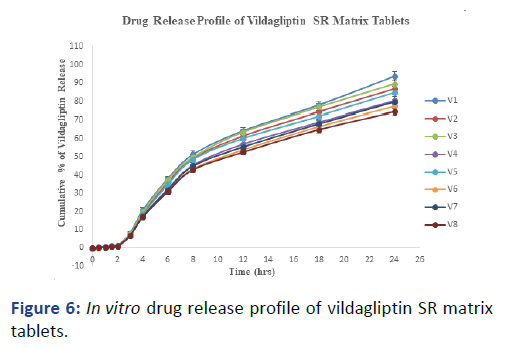
Figure 6: In vitro drug release profile of vildagliptin SR matrix tablets.
Drug Release Kinetic Studies
The drug release data was applied into different kinetic equations to get respective linear plots with Regression (R2) values (Table 15). The results obtained through kinetic treatment of dissolution data have confirmed a sustained and controlled manner drug release from all prepared matrix tablets. The drug release form all eight vildagliptin matrix formulations was found to be concentration dependent because of resulted higher R2 values for first order plots. In case of all eight formulations, more linearity has been noticed with Hixson-Crowell followed by Higuchi plots with slight difference. So, the drug release from all vildagliptin matrix formulations can be through surface erosion followed by diffusion mechanisms.
| Formulation | Zero order | First order | Higuchi | Korsemeyer-Peppas | Hixson-Crowell | |
|---|---|---|---|---|---|---|
| R2 | R2 | R2 | R2 | n | R2 | |
| V1 | 0.9325 | 0.9721 | 0.9731 | 0.9357 | 1.7268 | 0.9884 |
| V2 | 0.9247 | 0.992 | 0.9689 | 0.9234 | 1.6678 | 0.9825 |
| V3 | 0.9264 | 0.9916 | 0.9708 | 0.9378 | 1.7344 | 0.9866 |
| V4 | 0.9269 | 0.9903 | 0.9703 | 0.9301 | 1.7649 | 0.9769 |
| V5 | 0.9236 | 0.9905 | 0.9681 | 0.931 | 1.6425 | 0.9792 |
| V6 | 0.9294 | 0.9897 | 0.9721 | 0.916 | 1.9852 | 0.9762 |
| V7 | 0.929 | 0.9904 | 0.9711 | 0.9309 | 1.7678 | 0.9777 |
| V8 | 0.923 | 0.9848 | 0.9696 | 0.9099 | 1.6442 | 0.9693 |
Table 15: Kinetic treatment for vildagliptin release data.
Randomized 23 Full Factorial Optimization and Mathematical Modeling
The obtained in vitro drug release data (cumulative % drug release after 24 hours) of eight formulations was subjected to ANOVA test using DOE software to identify significant terms (with p<0.05) used in multiple regression equation. The selected modified model used in software for ANOVA testing was proved to be significant (p<0.05) (Table 16).
| Source | Sum of squares | Degree of freedom | Mean square | F-value | p-value | |
|---|---|---|---|---|---|---|
| Model | 299.03 | 6 | 49.84 | 23592.48 | 0.005 | Significant |
| A-Amount of HRLM | 104.47 | 1 | 104.47 | 49454.92 | 0.0029 | |
| B-Amount of ZP | 43.48 | 1 | 43.48 | 20581.21 | 0.0044 | |
| C-Amount of TSP | 146.12 | 1 | 146.12 | 69169 | 0.0024 | |
| AC | 1.42 | 1 | 1.42 | 672.01 | 0.0245 | |
| BC | 0.8646 | 1 | 0.8646 | 409.28 | 0.0314 | |
| ABC | 2.68 | 1 | 2.68 | 1268.46 | 0.0179 | |
| Residual | 0.0021 | 1 | 0.0021 | |||
| Cor Total | 299.04 | 7 | ||||
Table 16: ANOVA for selected factorial model (Vildagliptin formulations).
The final regression equation containing only significant terms along with their respective estimated coefficients was as follows:
Y=83.26–3.61A–2.33B–4.27C+0.421AC+0.329 BC+0.579 ABC
The significant factors showing considerable effect on response were A, B, C and AC, BC, ABC. The value and sign of estimated coefficient possessed by each significant term are deciding tools for magnitude and direction of respective influence on response (Y). All main individual factors like A, B and C have shown the negative effect on ‘Y’ i.e. the decreased drug release has been resulted with an individual increase in any polymer quantity due to enriched cross linking within a formulation. The interaction factors like AC, BC and ABC have exerted the positive influence on response. An increased interaction of polymers present in a dosage form has led to enhanced drug release which may be due to enriched hydrophilicity and porosity. The contribution of factor C (TSP quantity) to decrease the drug release was 48.86%. The other main factors like A and B have contributed towards reduction of drug release up to 34.94% and 14.54%, respectively. The contribution of all three interaction terms towards enhancement of response was comparatively very less (Table 17).
| Term | Standardized effect | % Contribution |
|---|---|---|
| A-Amount of HRLM | -7.23 | 34.94 |
| B-Amount of ZP | -4.66 | 14.54 |
| C-Amount of TSP | -8.55 | 48.86 |
| AC | 0.8425 | 0.4747 |
| BC | 0.6575 | 0.2891 |
| ABC | 1.16 | 0.8961 |
Table 17: Contribution of significant terms towards response (Vildagliptin release).
The effect of factors like ‘A and C’ and ‘B and C’ on ‘cumulative vildagliptin release after 24 hours’ was visualized through Contour and 3D surface plots which were drawn by keeping other third polymer at low level (60 mg). All these plots have indicated the maximum drug release (93.63%) from a formulation composition having each polymer at its lower level (60 mg) (Figures 7-10).
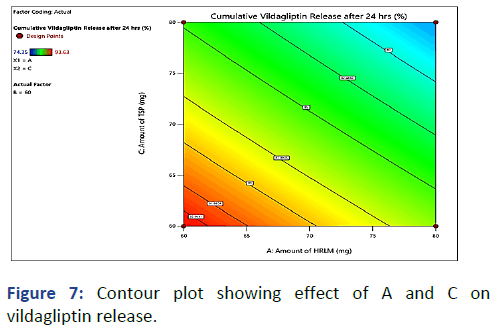
Figure 7: Contour plot showing effect of A and C on vildagliptin release.
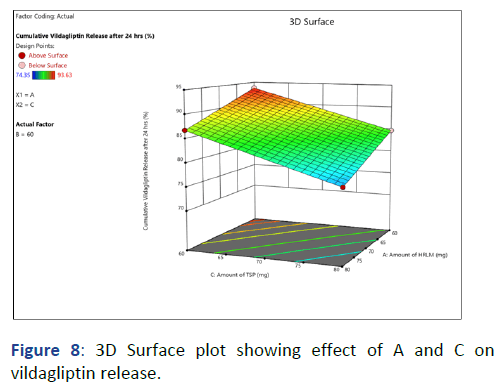
Figure 8: 3D Surface plot showing effect of A and C on vildagliptin release.
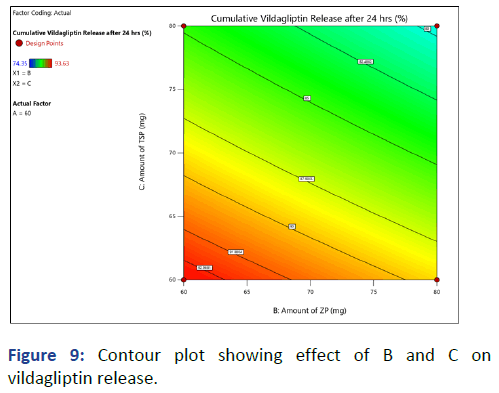
Figure 9: Contour plot showing effect of B and C on vildagliptin release.
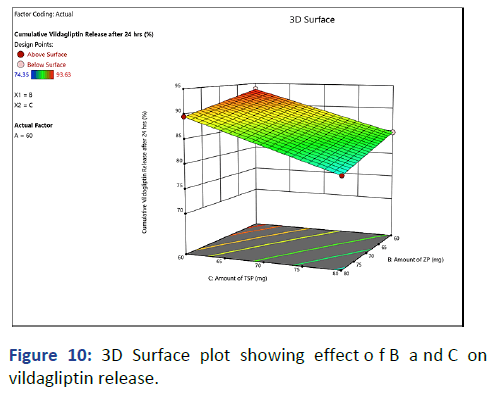
Figure 10: 3D Surface plot showing effect o f B a nd C on vildagliptin release.
The effect of three polymers on response (Y) was visualized by drawing cube plot (Figure 11). This plot also pointed the maximum drug release at a composition having all three polymers at low level (60 mg).
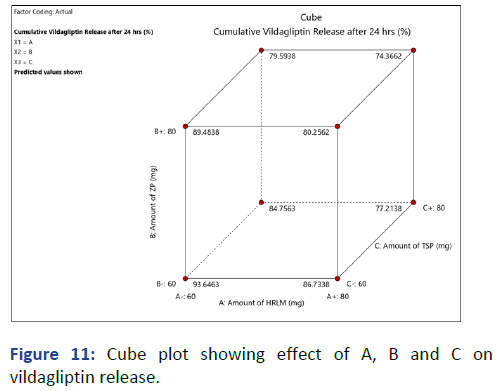
Figure 11: Cube plot showing effect of A, B and C on vildagliptin release.
All the plots drawn using modified statistical model have suggested a best optimized formulation composition which consisted of three polymers like HRLM, ZP and TSP, each at 60 mg quantity. This composition was same as that of developed V1 formulation. The statistical model has suggested a predicted cumulative drug release of 93.64% from optimized formulation. The predicted value was found to be very close to observed drug release response from V1 formulation (93.63%). So, V1 formulation was confirmed as best SR matrix tablet dosage form for vildagliptin and further used for stability and in vivo studies.
In vitro Drug Release: Marketed Versus Optimized Formulation
A complete vildagliptin release has been noticed from marketed product (Vysov, manufactured by Cipla Ltd.) within 6 hrs. The pattern of drug release was immediate and not in sustained manner from marketed formulation. But the objective of extended drug release was fulfilled by V1 formulation by releasing the drug slowly up to 24 hours (Figure 12). The promised sustained action and prolonged drug residence time can be expected from developed V1 formulation because of delayed release. So, it can be said that the V1 formulation may avoid the risk of frequent dosing which is practiced with Vysov tablets.
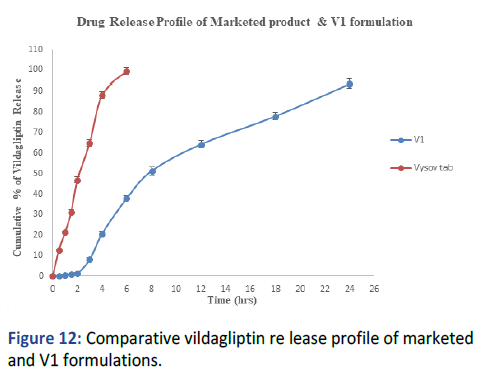
Figure 12: Comparative vildagliptin re lease profile of marketed and V1 formulations.
Stability Studies
No physical and chemical degradation of best optimized tablets (V1) has been noticed up to 180 days (Tables 18-20). The tested tablets have retained their important properties like drug content, swelling index and drug release during stability study (at three different stability conditions). It was confirmed that the tablets of selected optimized formulation (V1) can have long term stability at storage conditions.
| Parameter | Initial | After 30 days | After 60 days | After 90 days | After 180 days |
|---|---|---|---|---|---|
| Appearance | Appropriate | Appropriate | Appropriate | Appropriate | Appropriate |
| Weight (mg) | 402.46 ± 1.27 | 402.63 ± 0.91 | 401.49 ± 0.79 | 401.73 ± 0.83 | 402.49 ± 0.67 |
| Hardness (kg/cm2) | 4.2 ± 0.33 | 4.2 ± 0.16 | 4.1 ± 0.31 | 4.2 ± 0.11 | 4.1 ± 0.24 |
| Thickness (mm) | 3.47 ± 0.21 | 3.48 ± 0.19 | 3.48 ± 0.31 | 3.47 ± 0.22 | 3.49 ± 0.19 |
| Friability (%) | 0.69 ± 0.14 | 0.67 ± 0.14 | 0.68 ± 0.19 | 0.66 ± 0.23 | 0.68 ± 0.13 |
| Drug content (%) | 101.06 ± 1.03 | 100.76 ± 1.14 | 99.94 ± 1.77 | 99.67 ± 1.47 | 99.85 ± 1.53 |
| Swelling Index (%) | 182.36 ± 3.29 | 183.35 ± 1.66 | 185.48 ± 1.91 | 181.43 ± 1.09 | 182.67 ± 1.73 |
| CDR after 24 hrs (%) | 93.63 ± 2.66 | 94.66 ± 1.01 | 92.34 ± 1.16 | 93.49 ± 1.27 | 94.67 ± 1.81 |
Table 18: Stability data of optimized Vildagliptin formulation (V1) at room temperature.
| Parameter | Initial | After 30 days | After 60 days | After 90 days | After 180 days |
|---|---|---|---|---|---|
| Appearance | Appropriate | Appropriate | Appropriate | Appropriate | Appropriate |
| Weight (mg) | 402.46 ± 1.27 | 403.46 ± 1.06 | 401.82 ± 1.61 | 403.71 ± 1.38 | 402.46 ± 0.97 |
| Hardness (kg/cm2) | 4.2 ± 0.33 | 4.3 ± 0.27 | 4.2 ± 0.17 | 4.1 ± 0.19 | 4.2 ± 0.11 |
| Thickness (mm) | 3.47 ± 0.21 | 3.48 ± 0.07 | 3.47 ± 0.09 | 3.48 ± 0.11 | 3.48 ± 0.08 |
| Friability (%) | 0.69 ± 0.14 | 0.69 ± 0.13 | 0.68 ± 0.11 | 0.67 ± 0.14 | 0.66 ± 0.29 |
| Drug content (%) | 101.06 ± 1.03 | 100.32 ± 1.22 | 100.21 ± 1.19 | 99.93 ± 1.34 | 98.63 ± 2.08 |
| Swelling index (%) | 182.36 ± 3.29 | 183.28 ± 1.14 | 181.52 ± 1.67 | 184.91 ± 1.97 | 181.64 ± 1.27 |
| CDR after 24 hrs (%) | 93.63 ± 2.66 | 93.61 ± 1.04 | 94.82 ± 1.27 | 94.01 ± 1.03 | 95.08 ± 0.77 |
Table 19: Stability data of optimized Vildagliptin formulation (V1) at 30°C/60% RH.
| Parameter | Initial | After 30 days | After 60 days | After 90 days | After 180 days |
|---|---|---|---|---|---|
| Appearance | Appropriate | Appropriate | Appropriate | Appropriate | Appropriate |
| Weight (mg) | 402.46 ± 1.27 | 402.44 ± 1.27 | 400.64 ± 1.98 | 401.61 ± 1.67 | 400.74 ± 2.07 |
| Hardness (kg/cm2) | 4.2 ± 0.33 | 4.3 ± 0.12 | 4.2 ± 0.09 | 4.3 ± 0.11 | 4.1 ± 0.13 |
| Thickness (mm) | 3.47 ± 0.21 | 3.44 ± 0.37 | 3.46 ± 0.18 | 3.49 ± 0.16 | 3.47 ± 0.03 |
| Friability (%) | 0.69 ± 0.14 | 0.67 ± 0.14 | 0.68 ± 0.15 | 0.69 ± 0.07 | 0.68 ± 0.12 |
| Drug content (%) | 101.06 ± 1.03 | 99.16 ± 1.46 | 101.67 ± 1.41 | 100.19 ± 1.81 | 99.67 ± 1.31 |
| Swelling index (%) | 182.36 ± 3.29 | 183.46 ± 1.37 | 184.35 ± 1.17 | 182.67 ± 1.06 | 185.49 ± 1.64 |
| CDR after 24 hrs (%) | 93.63 ± 2.66 | 95.11 ± 1.94 | 94.69 ± 1.79 | 94.86 ± 1.36 | 93.91 ± 1.49 |
Table 20: Stability data of optimized vildagliptin formulation (V1) at 40°C/75% RH.
In vivo studies
The chromatogram obtained through developed HPLC method as two peaks at different retention times corresponding to both vildagliptin and internal standard. A good linearity as per Beer-Lambert law has been seen with constructed standard graph of vildagliptin in rabbit plasma. The generated drug concentration-time profile using constructed calibration curve is presented in Figures 13-15.
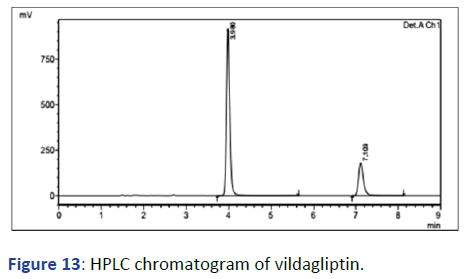
Figure 13: HPLC chromatogram of vildagliptin.
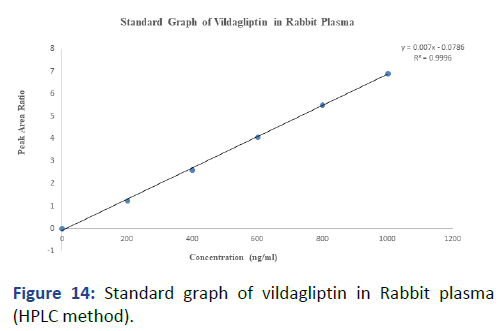
Figure 14: Standard graph of vildagliptin in Rabbit plasma (HPLC method).
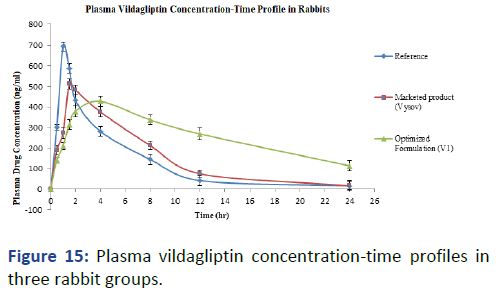
Figure 15: Plasma vildagliptin concentration-time profiles in three rabbit groups.
All the estimated PK parameters were presented in Table 21. The mean Cmax value in reference group was high and sharp (693.97 ± 11.81 ng/ml) compared to other two groups. The plasma drug concentration has reached to its maximum after 1 hour of dosing in reference group. The rapid drug absorption from reference solution has been confirmed by this result. The Tmax values for marketed product and V1 formulation were 2 hours and 4 hours, respectively. The rate of drug absorption from marketed tablet was also rapid and next to reference solution. But, the rate of vildagliptin absorption from optimized formulation (V1) was delayed due to extended drug release from dosage form. More mean values of AUC (6799.28 ± 54.63 ng.hr/ml) and MRT (18.6 ± 1.19 hrs) were resulted from third group which received V1 formulation compared to other two groups. The rabbits of first and second groups have shown mean AUC values as 3867.77 ± 42.16 ng.hr/ml and 5831.46 ± 37.19 ng.hr/ml, respectively. MRT values resulted from reference solution and Vysov table were comparatively less which may be due to rapid drug absorption and elimination. An increased oral bioavailability of drug from optimized formulation has been noticed and it may be due to enhanced residence time. The most convincing and promising benefits have been noticed with developed V1 formulation compared to conventional marketed product [18].
| PK parameter | Reference | Marketed product (Vysov) | Optimized formulation (V1) |
|---|---|---|---|
| Cmax (ng/ml) | 693.97 ± 11.81 | 512.56 ± 23.41 | 427.37 ± 13.44* |
| Tmax (hrs) | 1.0 ± 0 | 1.5 ± 0 | 4.0 ± 0 |
| AUC0-t (ng.hr/ml) | 3867.77 ± 42.16 | 5831.46 ± 37.19 | 6799.28 ± 54.63* |
| MRT (hrs) | 3.4 ± 0.69 | 4.8 ± 0.44 | 18.6 ± 1.19* |
| All values expressed as Mean ± SD; *Significant with p<0.05. | |||
Table 21: Pharmacokinetic parameters of vildagliptin in rabbits.
In vitro drug release from all developed sustained release matrix tablets was influenced by quantity of each polymer accommodated inside the dosage form. The extents of some deciding properties like swelling index, matrix forming ability and release retarding capacity were found to be more with TSP polymer followed by HRLM and ZP, respectively. The identified best optimized formulation was V1 (for vildagliptin) with a formulation composition consisting of all three polymers like HRLM, ZP and TSP, each at their lower level (60 mg). The results of stability studies and in vivo tests using animal models were satisfactory for these best formulations. The estimated pharmacokinetic parameters of drug for each best formulation were in support of obtained in vitro drug release profile indicating a good ‘In Vitro In-Vivo Correlation’ (IVIVC). Further research is required and recommended for future in vivo studies using human models to estimate all required pharmacokinetic parameters and to compare the same with obtained results in animal models.
[Crossref] [Google Scholar] [PubMed]
[Crossref] [Google Scholar] [PubMed]
[Crossref] [Google Scholar] [PubMed]
[Crossref] [Google Scholar] [PubMed]
[Crossref] [Google Scholar] [PubMed]
[Crossref] [Google Scholar] [PubMed]
[Crossref] [Google Scholar] [PubMed]
[Crossref] [Google Scholar] [PubMed]
[Crossref] [Google Scholar] [PubMed]
[Crossref] [Google Scholar] [PubMed].
[Crossref] [Google Scholar] [PubMed]
Citation: Deepika B, Sujatha K (2023) Design and Evaluation of Vildagliptin Matrix Tablets by Response Surface Methodology. Am J Drug Deliv Ther. 10:11.
Copyright: © 2023 Deepika B, et al. This is an open-access article distributed under the terms of the Creative Commons Attribution License, which permits unrestricted use, distribution, and reproduction in any medium, provided the original author and source are credited.